I have always been a fan of binoculars. They are the one astronomical instrument I have been using all my life. As a young boy growing up, I would save pocket money from doing chores, and money from birthdays and Christmas and, much to my parents' dismay buy (more!) binoculars with it, hoarding quite a collection.
The reason was simple, I just could not afford to buy a ‘proper’ telescope. I had a couple of department store telescopes, the ones that advertise 600x magnification at 60mm aperture, mounted on a tripod made from spaghetti that shook if you happened to just breathe on the scope. I was frustrated with these and never got any decent viewing in. I was fortunate at the time that my parents' house was in the countryside, and I was gifted with truly dark skies.
I grew up reading books like Leslie Peltier's ‘Guide to the Stars’ and Patrick Moore's ‘Exploring the night sky with Binoculars’ alongside Wil Tirion's ‘Sky Atlas 2000’. Very quickly I could get out in the garden and see the things they described in the books, comparing the views with different pairs of binoculars. I had numerous pairs – 6x30, 7x35, 8x40, 9x63, 10x50, 12x50, 20x60. Then for my 16th birthday I bought a Manfrotto 055 tripod, which, 35 years later is still working well bar a few rusty fittings; this was a gamechanger as I had been hand holding binoculars prior to this and mounting them on a tripod suddenly revealed a whole new layer of night sky I could explore. It also meant I could start projecting images of the sun onto white card and looking at sunspots. My 18th birthday treated me with a pair of 11x80 binoculars to add to the complement.
I went off to university shortly after, taking some of the binoculars with me, alas now, living in the middle of the city meant the dark skies I had become accustomed to growing up were no more and now the binoculars were used more for watching planes or ships out at sea.
After university and moving into the world of work brought more disposable income and the telescopes that I wanted growing up, now became within reach. I am sure I am not alone here, and aperture fever set in, and I soon realized in the light polluted skies of the cities I lived in, the bigger the scope the brighter the sky background, especially looking for deep sky. By about 20 years ago I had all but given up the astronomy that I loved, and at one point realizing I had not been out under the night sky for over 2 years contemplated selling everything up and finding a new hobby.
Then a company called Coronado caught my eye and their range of solar telescopes. I thought I would give the skies one more shot, and figuring being able to observe in the daytime suited lifestyle better I was also certain there was not a streetlight near bright enough to drown out the sun. I was hooked! Before long I had a range of telescopes observing at a range of different wavelengths, and not learning my lesson from the first-time round aperture fever set in and the collection of scopes got ever more and ever larger. Poor local seeing conditions brought me back down to Earth and I soon realized some of the scopes I had amassed for solar I could only effectively use once every couple of years. Throw in the less-than-ideal weather we have here in the UK, and I have less time to do solar than I would like.
There is a saying I heard, ‘the best scope is the one you use most often.’ I can see what this means, and for me back at the start of my solar journey this was a double stacked 40mm Coronado. I loved it, living on the Manfrotto 055 tripod I could pick it up and be outside and imaging in minutes. Fast forward to a couple of years ago, and I became aware of the Lunt 8x32 sunoculars, a dedicated solar binocular giving photospheric views. It was not long before I saw a pair come up on eBay for less than £100, and I decided to buy them and see what all the fuss was about. I was not disappointed, and before long I was out observing and using them at every opportunity, not just at home but with their portability I was taking them away on holiday, away to visit friends; the list goes on, they are well travelled!
Earlier in 2023 I became aware of the Celestron branded ‘Eclipsmart’ solar binoculars, in 10x42, 12x50 and 20x50 sizes. They piqued my interest, and in November I saw a pair come up on eBay which I managed to bag for the princely sum of £30, a bargain given the UK retail price of £89.99. So now I have 2 different pairs of solar binoculars and it is the perfect opportunity to make a direct comparison.
Packaging and Accessories
Both pairs of binoculars come in sturdy cardboard outer boxes and contained within a simple Cordura style case with Velcro fixing along with a strap. Both binoculars come with eyepieces and lens caps, in the case of the Celestron these are individual, rubber on the objectives and plastic on the eyepieces. The rubber objective ones are loose and easily come off, the eyepiece caps are a snug fit.
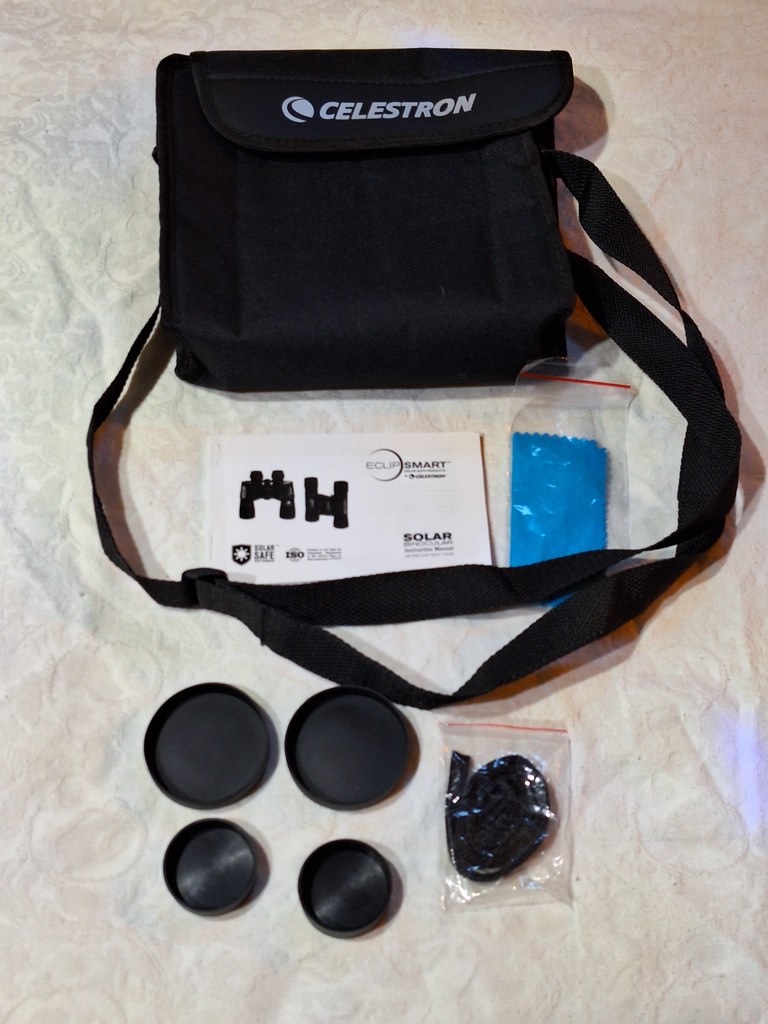 20231231_142555 by Mark Townley, on Flickr
20231231_142555 by Mark Townley, on Flickr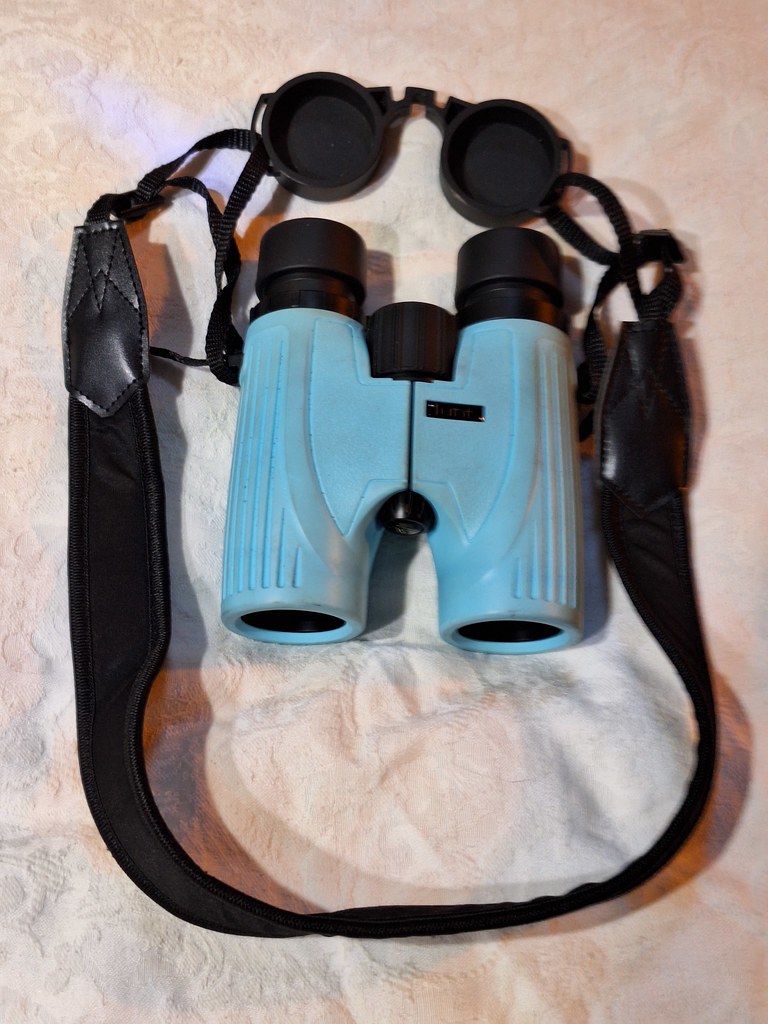 20231231_142758 by Mark Townley, on Flickr
20231231_142758 by Mark Townley, on FlickrThe Lunt on the other hand is a plastic pinch fit for the objective lens, but for the eyepieces these are a single rubber hinged unit that fixes onto the strap of the binocular, a nice touch which makes it harder to lose the lens caps. The strap on the Celestron is a simple piece of chord, 10mm wide, which is too thin and digs in around your neck, rudimentary at best. The strap on the Lunt is a wide padded affair, much more comfortable and functional.
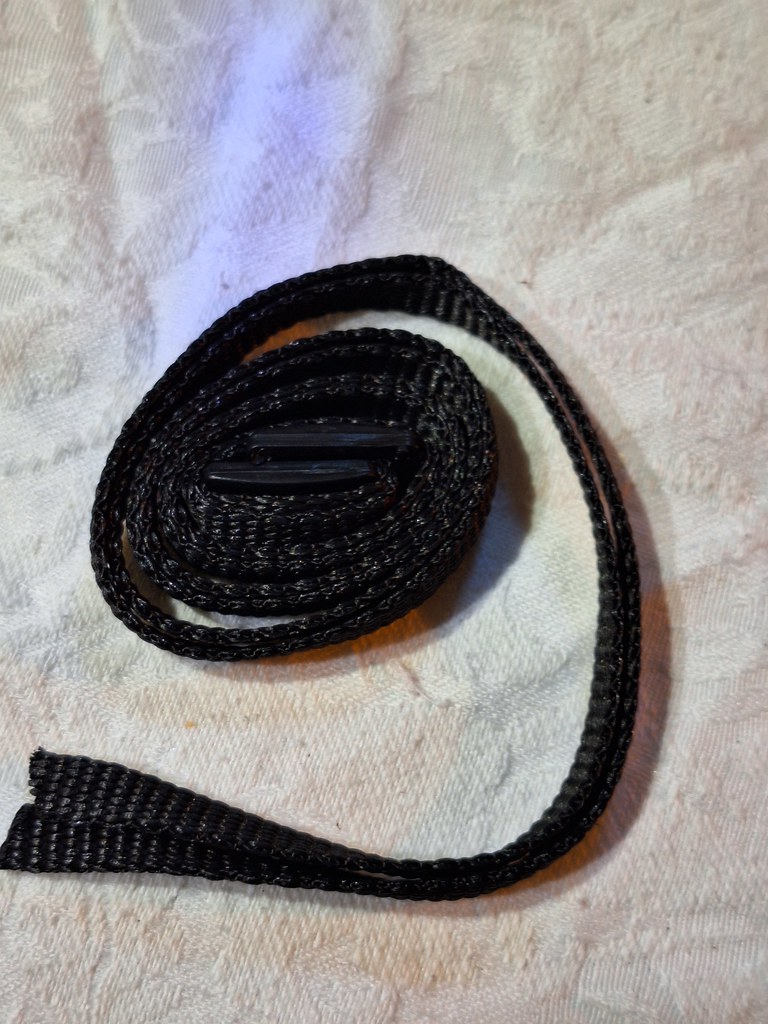 20231231_142624 by Mark Townley, on Flickr
20231231_142624 by Mark Townley, on FlickrBoth binoculars come with the obligatory silica gel and cleaning cloth in the case, and safety instructions / manual.
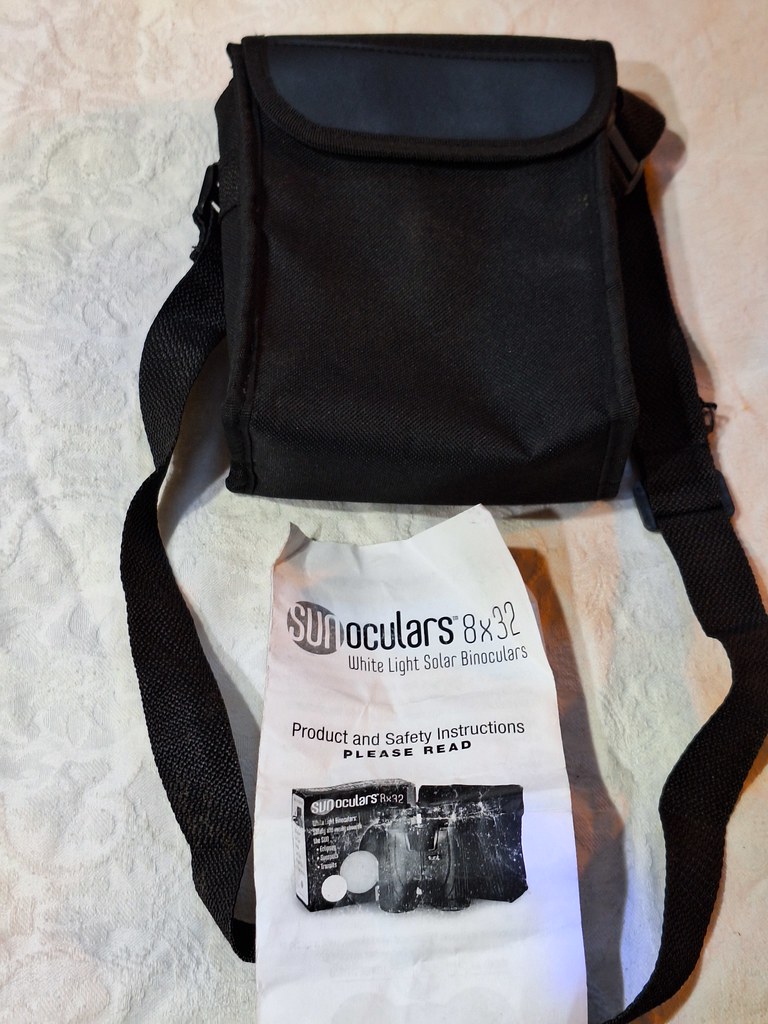 20231231_142730 by Mark Townley, on Flickr
20231231_142730 by Mark Townley, on FlickrBuild Quality
The Celestron comes in standard binocular ‘rubber black’ finish offering slight protection to their aluminum housing. This is a smooth finish and offers a textured rubber thumb grip on the underside of the body which helps the observer intuitively put their fingers and hands in the right place.
 20231231_142813 by Mark Townley, on Flickr
20231231_142813 by Mark Townley, on FlickrThe center focusing is pleasantly stiff with a decent sized textured wheel and offers a good degree of resistance to focus shifting, however there is visible play on the hinged arms that come out to each eyepiece which makes returning to focus tricky without lots of fiddling. Individual focus is available on the right eyepiece to allow calibration to the observers own vision, but adjusting this can cause the other eyepiece to lose focus.
There is a thread for attaching to a tripod which is a good touch by unscrewing the plastic cap with the Celestron logo on the hinge of the binoculars.
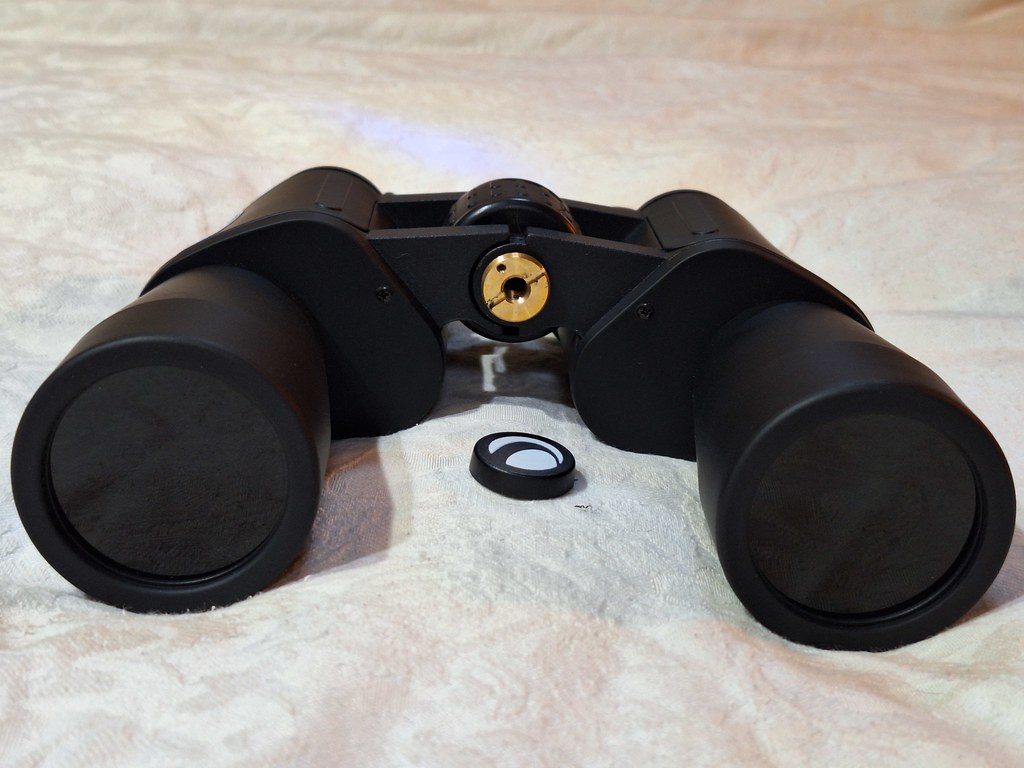 20231231_143112 by Mark Townley, on Flickr
20231231_143112 by Mark Townley, on FlickrA big downside for me is the eye cups on the lenses, these are only 5mm long against the 12.7mm eye relief, meaning there is a lot of light leak coming in around the periphery of the field of view. Being a porro prism design the Celestron and quite a bit wider around the objective end.
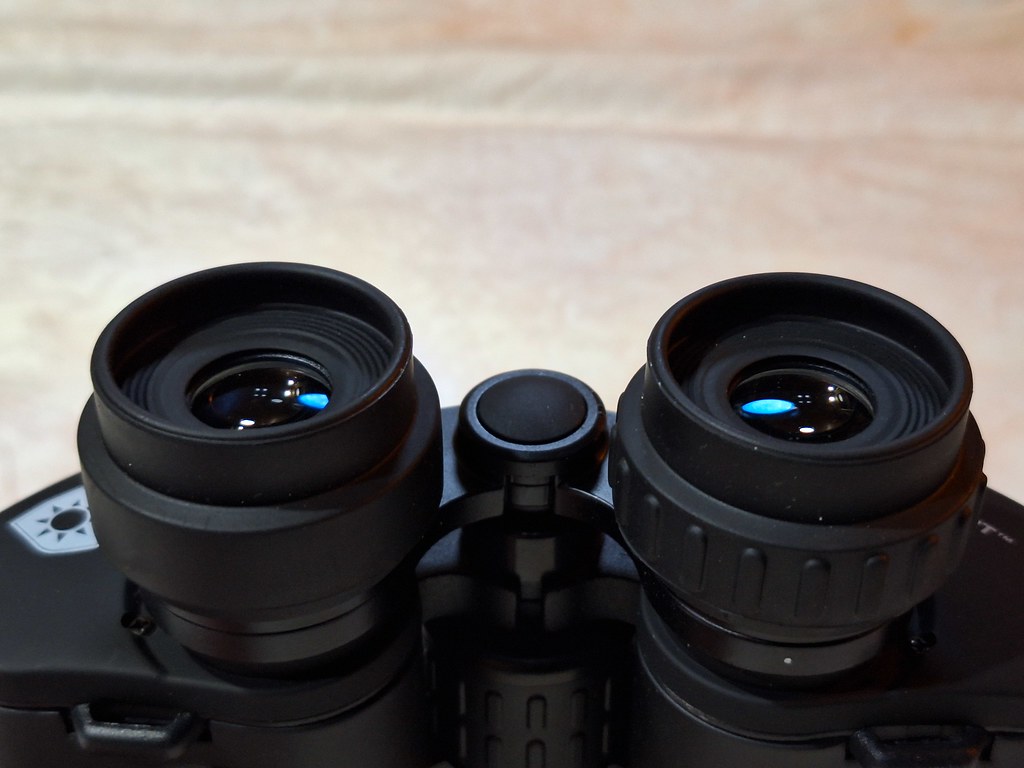 20231231_142929 by Mark Townley, on Flickr
20231231_142929 by Mark Townley, on FlickrThe Lunt comes in 4 colors; black, blue, red, and yellow, which is a nice touch. The colored rubber covering is quite a bit thicker than that on the Celestron and offers more protection against small knocks. The body is textured with deep grooves running the length of the binocular from objective to eyepiece which makes holding them easy, especially with cold hands.
 20231231_142758 by Mark Townley, on Flickr
20231231_142758 by Mark Townley, on FlickrThe center focusing wheel, like the Celestron, is pleasantly stiff. However, being a different design of binocular there is none of the lateral play between individual eyepieces making the focus precise first time around. As with the Celestron, there is individual focus on the right eyepiece allowing calibration to the observers own vision. There is no thread for attaching the binocular to a tripod.
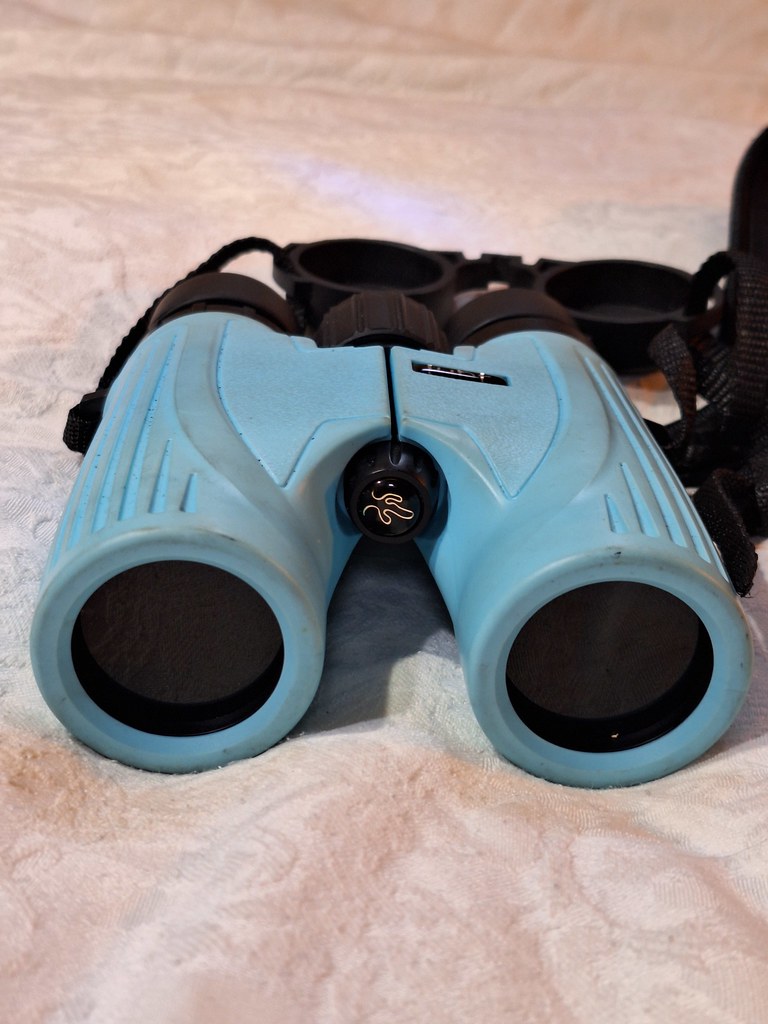 20231231_143046 by Mark Townley, on Flickr
20231231_143046 by Mark Townley, on FlickrThe eyecups on the eyepieces are retractable by twisting, allowing the observer to set these to their personal preference. These easily extend the full 13.6mm of eye relief this binocular affords, I found myself resting them on my eye socket when in use, something that was difficult with the Celestron.
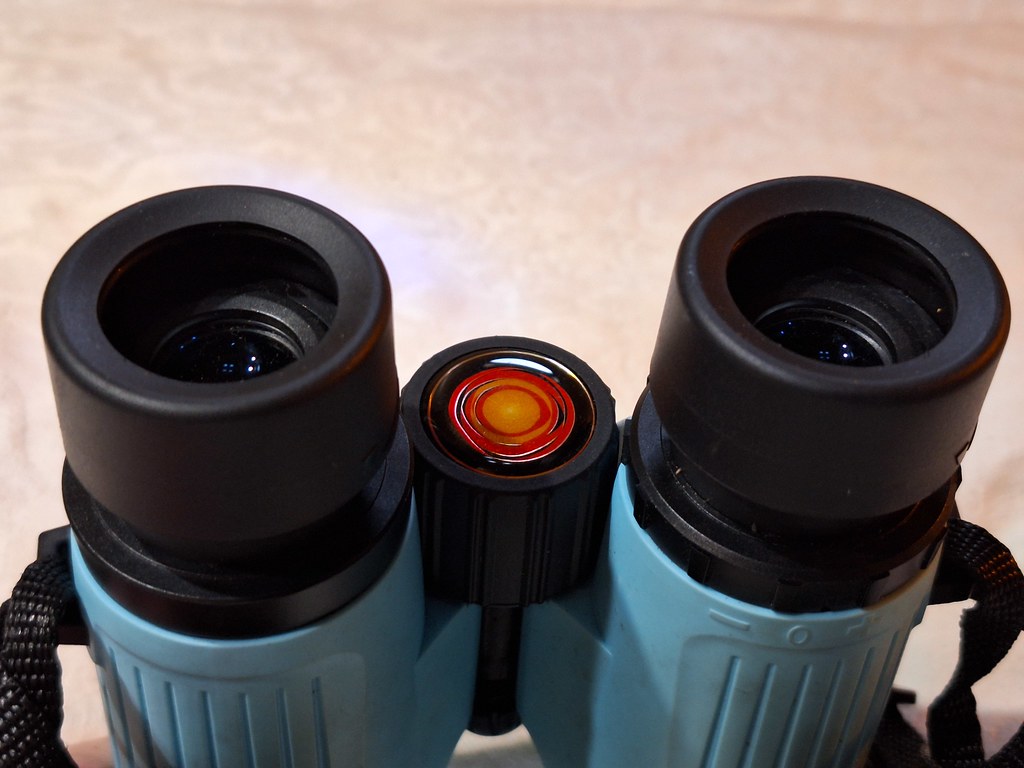 20231231_143001 by Mark Townley, on Flickr
20231231_143001 by Mark Townley, on FlickrThis makes for a much more comfortable viewing experience than the Celestron, but with both binocular things are improved by using a ‘binobandit’ neoprene eyepiece shade. Being a roof prism design, the Lunt are narrower around the objective end than the Celestron which makes them easier to hold and for longer.
In Use
Despite on paper superficially being a similar binocular; an 8x32 and 10x42, the reality is they could not be more different. I handheld both binoculars in this comparison, either free hold simply holding them whilst pointing at the sun, or, holding them with my elbows wedged into my body, or, sat down with my elbows resting on a ledge.
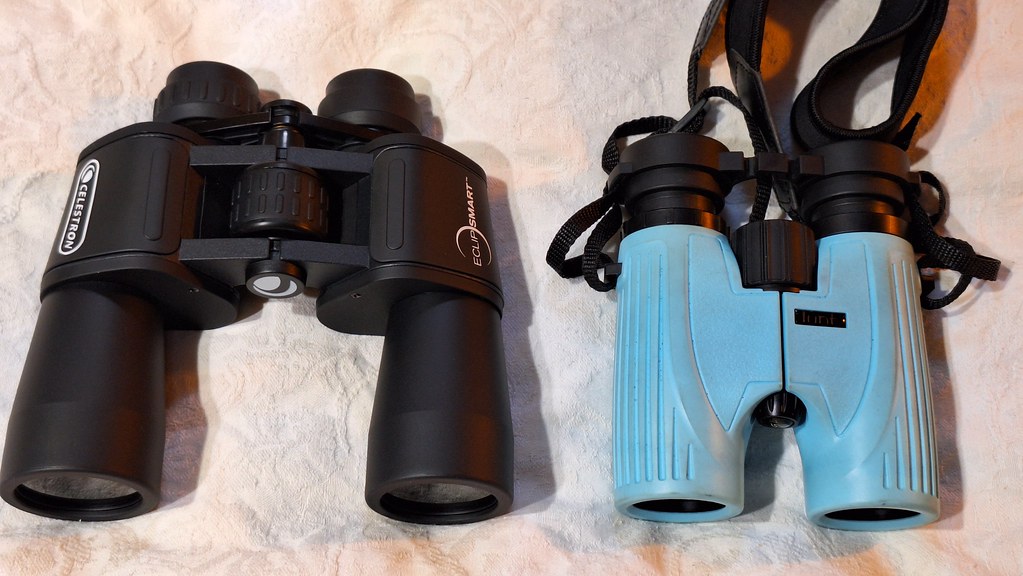 20231231_142853 by Mark Townley, on Flickr
20231231_142853 by Mark Townley, on FlickrThe Celestron displays a cool slightly bluish shade to the sun, whereas the Lunt is a warmer slightly orange shade to the sun. The Lunt let through more light than the Celestron and have a noticeably brighter view, not overly bright, but the Celestron was a lot darker in comparison. With Lunt it was much easier to see clouds around the sun, or branches silhouetted against the sky across the whole field of view, whereas Celestron clouds could only be seen half a degree or so around the sun. This made the Lunt more suitable for use in overcast or partially cloudy conditions where the Celestron was simply too dim. The Lunt binoculars are cited on their website as transmittance being 1x10-5, or ND5. The Celestron binoculars are cited on their website as being built to ISO 12312-2:2015(E) standards, which corresponds to ND6.4. Further information can be found here.
https://eclipse.aas.org/eye-safety/iso12312-2
Both sets of binoculars block UV and IR wavelengths. Both sets of binoculars displayed some color fringing around the sun, red on one side and blue on the other, however this could be due to atmospheric dispersion. The Lunt also had a noticeably bigger depth of focus, with foreground branches easily being in focus, whereas with Celestron they were not.
Something very apparent with the two binoculars is the weight difference, the Celestron are 33% heavier than the Lunt (24oz vs 18oz), this might not sound much but when hand holding the binoculars makes quite a difference in terms of shake. Coupled with the Celestron are 10x magnification to the Lunt 8x the effect of shake is compounded. It was very easy with the Lunt to hand hold the binoculars, have minimal shake, and easily see the sunspots. With the Celestron the sun's disk was bouncing around the field of view more.
Changing body posture and holding the binoculars with either elbows jabbed into the torso, or, sat down and resting elbows on a ledge improved things for both pairs of binoculars. It was surprising the difference in size of the sun with the 10x view compared to the 8x view. With the Lunt in this situation, it was very easy to focus and snap to focus, with the Celestron it was not as easy, and I found myself hunting through the focal point. I also found with the Celestron I was adjusting the individual eyepiece focus more, as mentioned earlier there is mechanical play in the hinged arm that connects the two eyepieces which I believe is the cause of the harder focus routine. With the Lunt this was not the case at all.
I chose a day to make comparisons with a quiet sun. The large single spot of AR13531 was on the western limb, and mid disk AR13534 with the leading spot having a much more defined umbra visible. The trailing spot had a much smaller umbra and was harder to make out, dancing in and out of view with changing seeing conditions. I could not make out AR13533 on the northwestern limb.
 sun 31st december by Mark Townley, on Flickr
sun 31st december by Mark Townley, on FlickrWith my elbows resting on a ledge, I thought the extra magnification of the Celestron might win the day here, but this was not the case. With a steady view it was clear the image through the Celestron was both softer and lacking in contrast compared to the Lunt. The black of the umbra was much blacker and it was easier to see the penumbra with the Lunt, compared to the Celestron which was greyer, and softer. Something I could not address through any change of focus. Imagine looking at a planet through a similar size SCT and an APO refractor, it is a similar difference in contrast and sharpness to draw analogy. It was just easier and more comfortable to observe with Lunt. The adjustable eyecups of the Lunt make it so much easier as you can set the perfect distance for yourself. The Celestron eye cups protrude about 5mm and are fixed, not great! I found if I rested them on my eye socket like I had done with the Lunt then they were too close, so I had to keep a gap between the binoculars and my eye, which did not help with stability. It must be said that both pairs of binoculars benefitted from a ‘Bino Bandit’ neoprene eye guard which keeps all light out.
Conclusions
I have been using both binoculars for about a month before writing a review so feel I've got to know the quirks of both pairs. You might think I would recommend the Lunt's over Celestron based on what I have seen and said; however, both are different binoculars, and both have their own place.
The Lunt are superior binoculars in terms of build and optical quality, and I think how I have been using mine over the past couple of years is the best way for them. They sit on my sideboard and when the sun is out, I quickly grab them, hand holding them and get a decent overview of the medium to larger sized sunspots that are visible. They are small and portable and will fit in a jacket pocket making them ideal for use away from home.
The Celestron are slightly too heavy and too powerful to effectively hand hold, however, they do have a thread for a tripod adapter, and, while I have not used them on a tripod, yet I do think this will improve things considerably. Yes, optically, and mechanically they are not as good as Lunt, but they are cheaper. I also think that if were able to have them permanently mounted on a tripod and grab the tripod and head outside for those quick views then this is their ideal use and would stop some of the focus issues I had. I think in this situation the user would not be disappointed.
When I set out to compare these two solar binoculars, I thought it would be an ‘apples for apples’ comparison, however spending some time with them both and it is clear it is an ‘apples for oranges’ comparison. If you want a solar binocular to hand hold only, go with the Lunt, if you want a solar binocular to be mounted on tripod then go for the Celestron.
Despite my observations of the optical and mechanical qualities of the Celestron, my experience is that this quality is typical of sub £100 binoculars, so, given the price point it is fair. The Lunt, however, is more typical binoculars in the £100-300 price point, with more attention to optical and build quality and haptics, so, given their $129 price point represent a bit of a bargain.
Get the right binoculars for the right use and neither will disappoint, both do what they say on the box.



